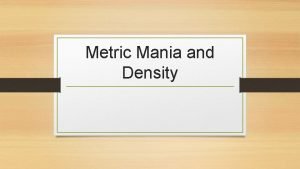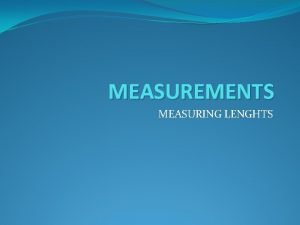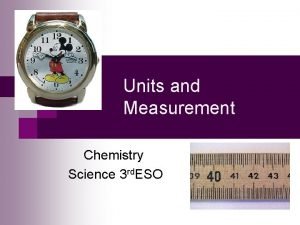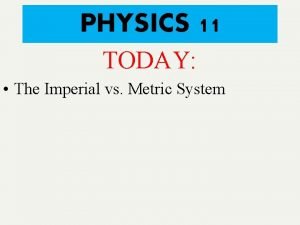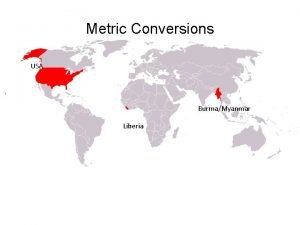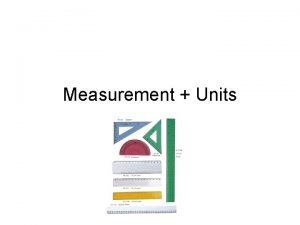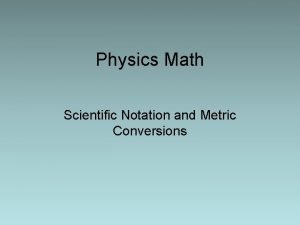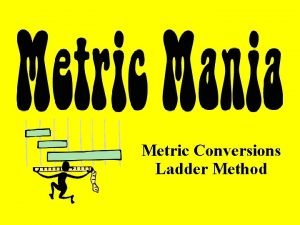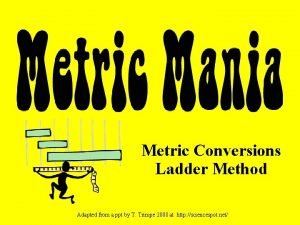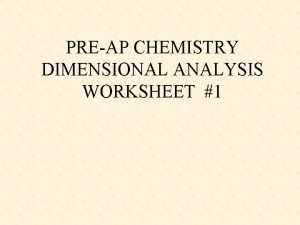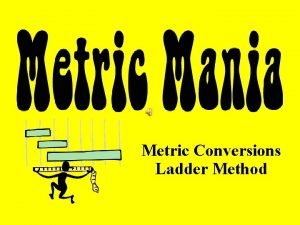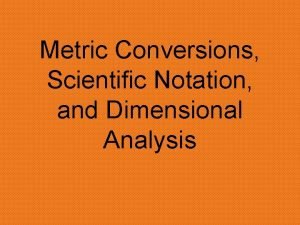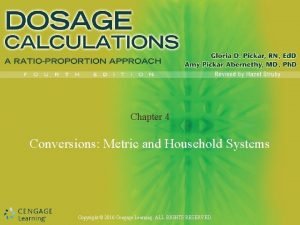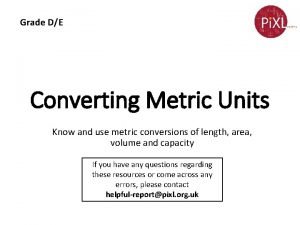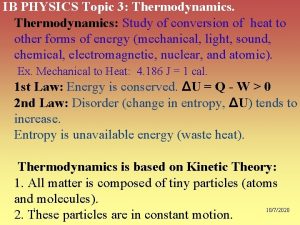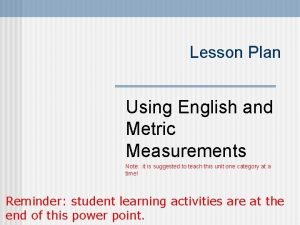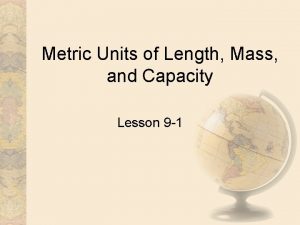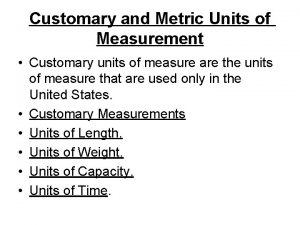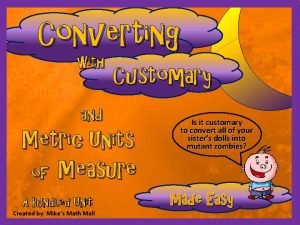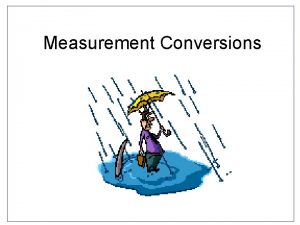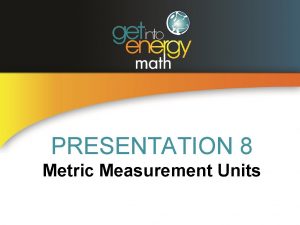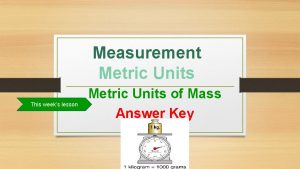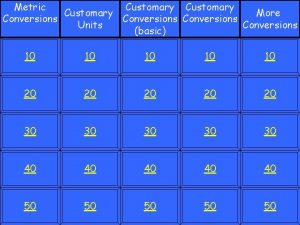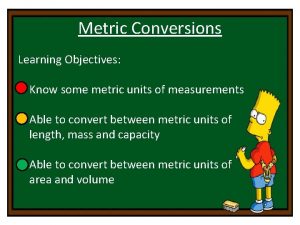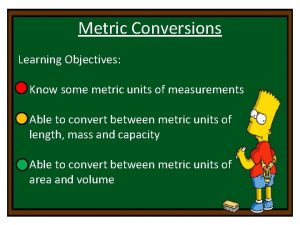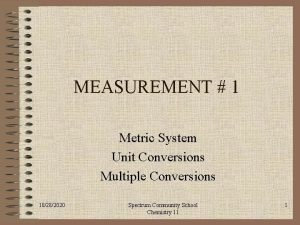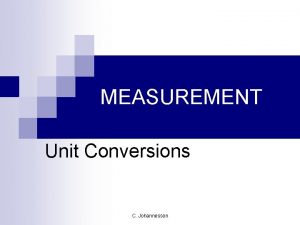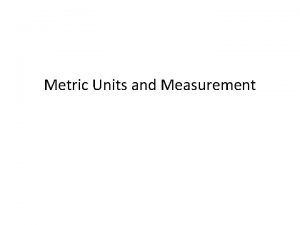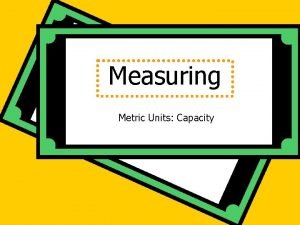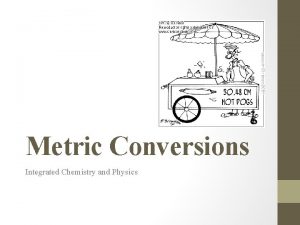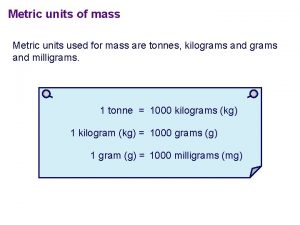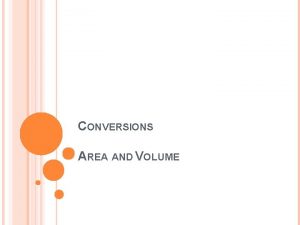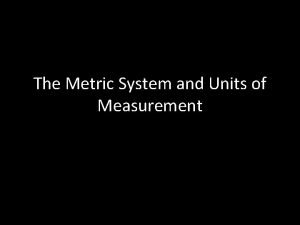Metric and Conversions Units and Measurement Physics Mrs






























- Slides: 30

Metric and Conversions

Units and Measurement Physics Mrs. Coyle http: //apod. nasa. gov/apod/image/0706/iss_sts 117_big. jpg

Countries that do NOT use Metric

Basic Physics – SI Units Quantity Length Unit meter Symbol m Mass kilogram kg Time second S Volume liter L

SI Unit Prefixes - Part I Name Symbol Factor tera- T 1012 giga- G 109 mega- M 106 kilo- k 103

SI Unit Prefixes- Part II Name Symbol Factor centi- c 10 -2 milli- m 10 -3 micro- μ 10 -6 nano- n 10 -9 pico- p 10 -12 femto- f 10 -15

Derived SI Units (examples) Quantity Unit Symbol Speed meter per second m/s Newton kg m/ s 2 N Energy Joule (kg m 2/s 2) J Pressure Pascal (kg/(ms 2) Pa

SI Unit Prefixes for Length Name Symbol gigameter Gm 109 megameter Mm 106 kilometer km 103 centimeter cm 10 -2 millimeter mm 10 -3 micrometer μm 10 -6 nanometer nm 10 -9 picometer pm 10 -12 1000 Mm 1000 km 1000 μm 1000 nm 1000 pm

Scientific Notation Mx n 10 or M En • M is the coefficient 1<M<10 • 10 is the base • n is the exponent or power of 10

Other Examples: 5. 45 E+6 or 5. 45 x 106

Numbers less than 1 will have a negative exponent. A millionth of a second is: 0. 000001 sec 1. 0 E-6 1 x 10 -6

Solving Word Problems • Analyze – List knowns and unknowns. – Draw a diagram. – Devise a plan. – Write the math equation to be used. • Calculate – If needed, rearrange the equation to solve for the unknown. – Substitute the knowns with units in the equation and express the answer with units. • Evaluate – Is the answer reasonable?

Unit Conversions Dr. John Mattox Department of Chemistry and Physics Fayetteville State University 1200 Murchison Rd. Fayetteville, NC 28301

How to Convert Units Made Easy

Converting 10 inches to centimeters 10. 0 in = cm We start by writing down the number and the units given and units of what we want

Our conversion factor for this is 1 in = 2. 54 cm. Then 2. 54 cm = 1 in 1 Multiplying by 1 does not change the value!

Converting Inches to centimeters 10. 0 in = cm Our conversion factor for this is 1 in = 2. 54 cm.

Converting Inches to centimeters 10. 0 in 2. 54 cm = 1 in cm Our conversion factor for this is 1 in = 2. 54 cm. Since we want to convert to cm, cm goes on the top.

Converting Inches to centimeters 10. 0 in 2. 54 cm = 1 in cm Our conversion factor for this is 1 in = 2. 54 cm. Since we want to convert to cm, cm goes on the top. Inches go on the bottom and are cancelled

Converting Inches to centimeters 10. 0 in 2. 54 cm = cm 1 in Leaving us with cm – the unit we want.

Converting Inches to centimeters 10. 0 in 2. 54 cm = 25. 4 cm 1 in Since the unit is correct, all that is left to do is the arithmetic. . . The Answer

Even though we have two different numbers and two different units, they represent the exact same length. You can check this by looking at a ruler – find the 10 in mark and directly across at the cm side. What number do you find?

A more complex conversion km to m hr s In order to work a NSCI 110 homework problem, we need to convert kilometers per hour into meters per second. We can do both conversions at once using the same method as in the previous conversion.

A more complex conversion km to m hr s 80 km hr Step 1 – Write down the number and the unit!

A more complex conversion km to m hr s 80 km 1 hr hr 3600 s m = s First we’ll convert time. Our conversion factor is 1 hour = 3600 sec. Since we want hours to cancel out, we put it on the top.

A more complex conversion km to m hr s 80 km 1 hr 1000 m hr 3600 s 1 km m = s Next we convert our distance from kilometers to meters. The conversion factor is 1 km = 1000 m. Since we want to get rid of km, this time it goes on the bottom.

A more complex conversion km to m hr s 80 km 1 hr 1000 m hr 3600 s 1 km m = s Now comes the important step – cancel and collect units. If you have chosen the correct conversion factors, you should only be left with the units you want to convert to.

A more complex conversion km to m hr s 80 km 1 hr 1000 m hr 3600 s 1 km 80, 000 m 3600 s = Since the unit is correct, we can now do the math – simply multiply all the numbers on the top and bottom, then divide the two.

A more complex conversion km to m hr s 80 km 1 hr 1000 m hr 3600 s 1 km 80, 000 m m = 22 s 3600 s = The Answer!!

80 km/hr and 22 m/s are both velocities. A car that is moving at a velocity of 80 km/hr is traveling the exact same velocity as a car traveling at 22 m/s.
 Metric mania metric conversions
Metric mania metric conversions Choose the appropriate metric unit to measure each item
Choose the appropriate metric unit to measure each item Metric units of measurement
Metric units of measurement Basic conversions
Basic conversions Si metric units
Si metric units Metric conversion ladder method
Metric conversion ladder method Derived quantities
Derived quantities Opisometer is used to measure
Opisometer is used to measure Scientific notation and metric conversions
Scientific notation and metric conversions Metric conversion step ladder
Metric conversion step ladder Ladder method metric system
Ladder method metric system Dimensional analysis metric conversions
Dimensional analysis metric conversions Acronym for metric conversions
Acronym for metric conversions Household conversion chart
Household conversion chart Metric conversion jeopardy
Metric conversion jeopardy Pre ap chemistry worksheet answers
Pre ap chemistry worksheet answers Metric system ladder
Metric system ladder Scientific notation and dimensional analysis
Scientific notation and dimensional analysis Mathematical literacy measurements grade 12
Mathematical literacy measurements grade 12 Household conversions chart
Household conversions chart Conversions of units
Conversions of units They are mrs garcia and mrs castro
They are mrs garcia and mrs castro They are mrs garcia and mrs castro
They are mrs garcia and mrs castro Ib physics topic 3
Ib physics topic 3 English metric system
English metric system English and metric units
English and metric units Length mass and capacity
Length mass and capacity Customary and metric system
Customary and metric system Converting customary units
Converting customary units Mrs. darling was ___________ of mrs. s.
Mrs. darling was ___________ of mrs. s. Metric measurement virtual lab
Metric measurement virtual lab
